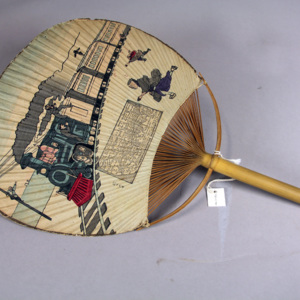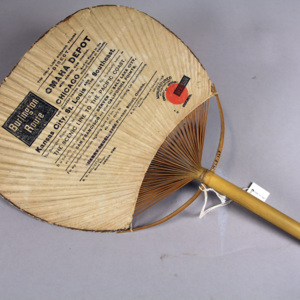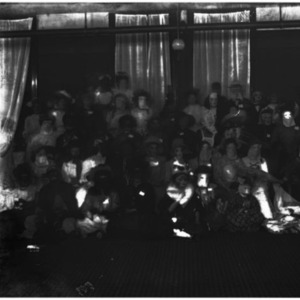Burlington Route Japanese Fan Advertisement
Title
Subject
Description
Students in the United States are taught from a young age about the importance of the railroad as a method of transporting people and products across the country. The expansion of the railroads is central to American history and crucial to the concepts of westward expansion and the frontier. While it is true that railroads are a prominent part of the country’s past, they also had an impact on the global environment and economy. Additionally, this global relevance was able to be seen and capitalized upon even in the middle of United States. The use of a Japanese-style fan as an advertisement for the Burlington Railroad reflects the globalized cultural interconnectivity that defined an industrial era of worldwide exchange and trade.
- What is the Object?
This object is a handheld fan advertising the Burlington Railroad. (Figure I) The fan is made in the Japanese style out of paper and bamboo. On one side, a written advertisement for the Burlington Railroad highlights the expanse of the railroad and its many stops throughout the country. On the reverse side of the fan, a drawing depicts several men, clearly meant to be Japanese, riding on a train or running alongside of it. (Figure II) This side of the fan also includes an inset map of the Burlington Route from California to Chicago. Judging from the names printed on the back, this fan was most likely produced and distributed by the Burlington Railroad sometime between 1882-1888, when George W. Holdredge served as general manager and P.S. Eustis was the general passenger and ticket agent in Omaha.
As indicated by a stamp on the reverse side of the fan, it was likely manufactured in a factory in Osaka, Japan. It was probably then shipped to the United States and distributed by the Burlington Railroad as a marketing tool. A. A. Vantine and Co., a New-York-based Asian trading company, supplied Japanese fans to companies such as Burlington Railroad. Each fan may have cost Burlington roughly one to two and half cents, and the company was estimated to have spent around $275,000 annually for the fans, as of 1904 (Printer’s Ink). This means that in one year, the Burlington Railroad may have spent over eight million (in 2018 dollars) for roughly 11,000-27,500 fans.
Although produced in the nineteenth century, the fan draws from a longer history of European fascination with “exotic” items from Asia. According to Edward Said, this fascination stems from Western culture historically structuring the Orient as “other” (Said). The term Japonisme, or Japonism, describes the desire for items from Japan in particular. (Figure III) Fans, to be specifically used as fashionable accessories, became popular in Europe in the 18th century and soon began to be painted with images to commemorate national events, give instructions, or make statements. The popularity of Japanese fans extended to the U.S. after the Civil War (Flory). Many railroads decided to take advantage of this trend for marketing purposes. For example, the Burlington Route, a successful railway, drew from Japonisme and a cultural fascination with “exotic” Asia to create their fan advertisement. This fan represents cross-cultural exchange, the railroad’s role in travel, tapping distant resources, and the Western commodification of Asian aesthetics.
III. Historical Context Omaha
The Burlington Route Fan is representative of the rise in globally-integrated industry in Omaha during the early 1900’s. The use of decorative fans for advertising purposes was not specific to Omaha. Trading companies in places like New York City, such as A.A. Vantine and Co., sold Japanese fans to companies for advertising purposes. These fans were not intended to appeal to a single urban area, nor did they limit their advertisements to Japanese-derived aesthetics. A.A. Vantine and Co. also used Chinese and Turkish objects in similar ways (Printer’s Ink). Although the Japanese-style fans were not specific to Omaha, the Burlington Route itself played a huge role in industrial and economic growth for the city. Burlington was a railroad company that mainly operated in the Midwest, including stops in Chicago, Minneapolis and St. Paul, St. Louis, Kansas City, and Denver (Overton). In the late nineteenth century, it was also notable for connecting the Midwest with California railways. The Burlington Route connected the country’s large cities and allowed for long-distance and cross-country travel. As it is conveniently located in the middle of the country, the railroad business boomed in Omaha. Rail caused Omaha to become a national hub for the transportation of both people and goods, and it was especially crucial for the transportation of Nebraska’s agricultural produce. Railroad held a place of prominence in the Trans-Mississippi International Exposition in 1898, which highlighted Omaha’s industrial and commercial accomplishments. The event focused on the way railroad led to transnational trade; for instance, many buildings were made from out-of-state materials brought in by rail (Center). The Trans-Mis Exposition presented Omaha to the rest of the world as a city full of economic potential, thanks to the railroad industry.
Effective advertising was important for rail companies like Burlington, as railroads had to compete with other methods of long-distance transportation. A good example of this competition is Harry Deuel, whose name appears on the back of the Burlington Route Fan as a contact for the railroad. Deuel was a steamboat agent, but he transitioned to becoming a traveling agent for Hannibal and St. Joseph Railroad as the industry expanded. Deuel began working for the Burlington Route soon after it came to Omaha. Along with competition from steamboat and stage companies, the Burlington also competed with other railroads (Lewis). Traveling agents such as Deuel were subsequently critical for advertising the unique assets of the Burlington. With the connections to California, the Burlington Railroad could take people in the Midwest farther than ever before. Burlington sought to expand on this perception by marketing themselves as a way to experience an exotic adventure in the West. In fact, some of the slogans used by the Burlington Route were “Everywhere West” and “Way West” (Overton). In this way, the West served as an “exotic” location as a result of the influence of its Asian population. Burlington subsequently tried to associate itself with the “exotic” reputation of California (and the Far East by extension) through its use of the Japanese fans. Additionally, the fascination with foreign objects was most prominent among the upper- and middle-class. By specifically capitalizing on the wealthy’s interest in Japonism, Burlington was advertising the railroad to these communities in particular. As a result, the railroads in Western and Midwestern cities were able to receive the funds needed to stimulate economic growth and cause further expansion.
- Historical Context Anthropocene
The Burlington Route fan represents the connection between cities like Omaha, a central location for transcontinental trade, and the developing networks of global commerce. In the nineteenth century, the importance and value of transportation, trade, and growth increased, which subsequently contributed to the changing physical landscape (Richards). Railroads fueled urbanization and increased the ecological footprint of cities, especially in the Western and Midwestern United States (Decker). This second wave of industrialization also led to the rapid acceleration in fossil fuel consumption and carbon dioxide emissions (Foster). Railroads also expanded agricultural commodity frontiers and encouraged westward expansion. This had a huge impact on the land, as migrant farmers began to clear more land for agriculture and displaced native peoples. In fact, two-thirds of the increase in cultivated land during that time can be linked directly to the railroad’s appearance in the Midwest (Atack). The railroad represented the literal transportation of goods and people, which would not have been possible without consequences for the physical environment.
The Burlington fan also reflects the influence of global trade and cultural exchange. Items manufactured in Japan were able to be sold and distributed to Americans, which points to a history of international commerce and a pre-Columbian Western fascination with Asian commodities. Upper-class Europeans frequently sought out Asian goods and artifacts (Said). They saw them as exotic curiosities that represented style and class. This continued well into the 20th century, especially as the “novelty [of Asian ornaments and effects] appeal[ed] to women, and… promise[d] to develop into a real fad” (Printer’s Ink). Even though Japan was isolationist for over 200 years, the existence of merit worthy transportation and technology allowed the Japanese artistic style to quickly become fashionable to Westerners.
Besides cultural exchange, Japan was able to prosper industrially and economically through its new relationship with the West. In the period from around 1868 to 1912, known as the Meiji Restoration, the Japanese government led efforts to modernize various industries in the country (Asia). One of the most important developments of this era was the growth of a national railroad system. Undoubtedly, many contributions to the construction of the railroad were made by those who had worked as railroad laborers in the U.S. Japan’s growing participation in the global trade industry resulted in significant economic and technological advancements. These developments inside of the country allowed for even more partnerships and collaboration between Japan and many Western countries. The prowess of international industry and trade led to further global communication and cultural exchange as well. As a result, companies like the Burlington Railroad were able to advance themselves through the use of Japanese-style fans.
- Current Context Anthropocene
Although decorative fans are not as popular today, people are still fascinated by foreign objects that represent other cultures. Exoticism remains a powerful influence in the Western imagination, and marketing companies still cater to consumers’ desire to experience other cultures. The Burlington fan is a very unique product of early international trade for commodities. For the majority of the nineteenth century, international trade was limited to only high-value commodities, but shortly before the turn of the century, we see a change in trade as a result of increased transportation methods (Hummels). The vast expansion of trade allowed international companies to create more of what they could make efficiently, and trade for the rest. This trend that we see even stronger today has allowed for a much higher level of industry than we’d be able to achieve without trade. With much larger trade, production, and transportation industries, however, comes a much larger ecological footprint on the earth’s system.
For all its benefits, globalization has the ability to cause significant damage to the global environment. Continuous advancements in technology have caused nations to become more and more interconnected. As a result, a larger global market for goods arises, which causes human consumption to increase. The production and manufacturing of goods therefore must increase, which puts a strain on the environment through the use of natural resources. The depletion of natural resources, as well as the use of fossil fuels for energy, perpetuates a cycle of harm to the earth. Subsequently, humans must find more intrusive and destructive ways to harvest resources and transport those resources around the world, furthering damaging ecosystems. That being said, globalization has the capability to be used positively for the environment. International coordination in the integration of trade and environmental policy may result in a “more sustainable economic growth” where “globalization can be harnessed for the benefit of the environment” (Panayotou). Since at least the late nineteenth century, the planet’s environment has been harmed by the globalization that came as a result of advancing transportation and technology.
This connection to globalization is the important link between the railroad and the Anthropocene. Not only did railroad physically transport people from place to place, but it also represented the ability to interact with the whole world. Railroads like Burlington Route “represented, if not always in reality, then at least in the public's imagination, the great, indelible link to the rest of the world and to the progress of the future” (White). Cultural exchange is as much of a result of the railroad as environmental impacts like fuel usage, pollution, and land development. At its most prominent, the railroad industry led to increased globalization due to the increased ability for people, cultures, and goods to be spread from place to place. However, it also was a result of globalization already taking place, as seen in the fan. The globalization is evident in both the economic exchange between Japanese and American companies and in the use of the Japanese style and culture to market the railroad to Americans.Creator
Tressa Wahl
Source
Asia for Educators. “The Meiji Restoration and Modernization.” Columbia University, 2009. Accessed 10 Dec. 2018. http://afe.easia.columbia.edu/special/japan_1750_meiji.htm
Atack, Jeremy, and Robert A. Margo. “The Impact of Access to Rail Transportation on Agricultural Improvement: The American Midwest as a Test Case, 1850–1860.” Journal of Transport and Land Use, vol. 4, no. 2, 2011, pp. 5–18.
Center for Digital Research in the Humanities. “Trans-Mississippi and International Exposition.” University of Nebraska Lincoln. Accessed 10 Dec. 2018. http://trans-mississippi.unl.edu/
Decker, Christopher S., and David T. Flynn. “The Railroad’s Impact on Land Values in the Upper Great Plains at the Closing of the Frontier.” Historical Methods, vol. 40, no. 1, Winter 2007, pp. 28–38.
Flory, M. A. A Book about Fans: the History of Fans and Fan-Painting. Macmillan and Company, 1895.
Foster, David, et al. “The Importance of Land-Use Legacies to Ecology and Conservation.” BioScience, vol. 53, no. 1, 1 Jan. 2003, pp. 77–88.
Hummels, David. 2007. "Transportation Costs and International Trade in the Second Era of Globalization." Journal of Economic Perspectives, 21 (3): 131-154.
Lewis, Miles D. “”None of them Remember those Times”.” Journal of the West, vol. 52, no. 1, 2013, pp. 48-64.
“The Unusual Store,” Printer’s Ink, Marketing Communications. Vol. 46. Pennsylvania State University, 1904. 11-14.
Overton, Richard C. Burlington Route; a History of the Burlington Lines. 1st ed., University of Nebraska Press, 1977. Print.
Panayotou, Theodore. “Globalization and Environment.” Center for International Development at Harvard University, 2000.
Richards, Susan L. “”Man + Opportunity = Success”: D. Clem Deaver Sells Himself.” Great Plains Quarterly, vol. 34., no. 4, 2014, pp. 317-339.
Said, Edward W. (2006). Orientalism. Brantford, Ont.: W. Ross MacDonald School, Resource Services Library.
White, Richard. “Shaping the West.” The Spatial History Project at Stanford University. Accessed 26 Nov. 2018.
http://web.stanford.edu/group/spatialhistory/cgi-bin/site/project.php?id=997.Rights
Collection
Citation
Embed
Copy the code below into your web page


